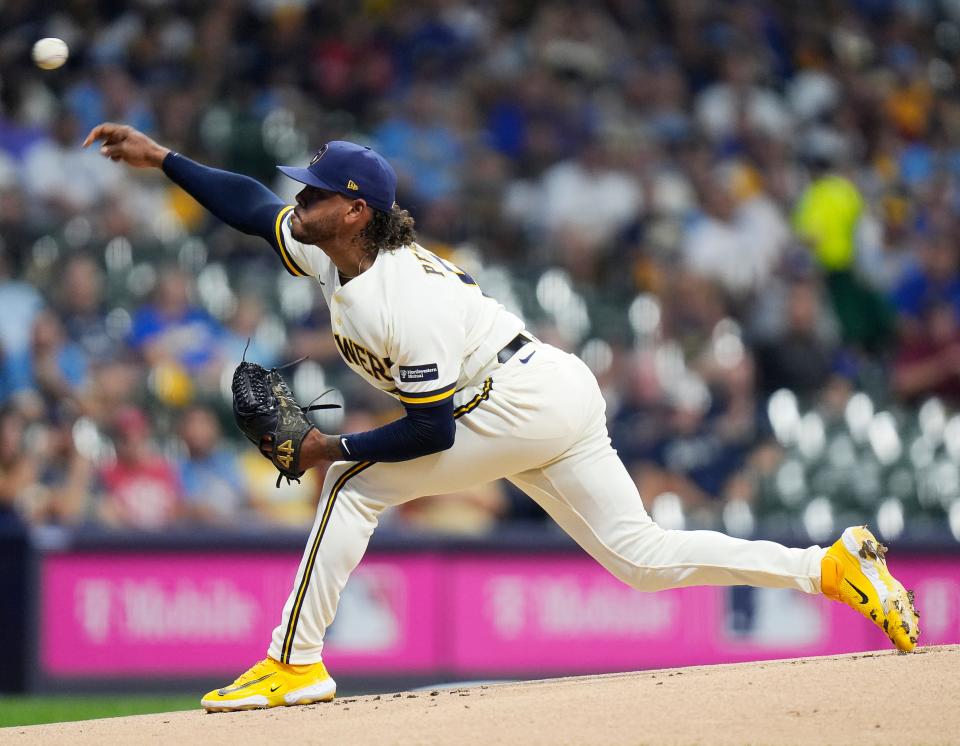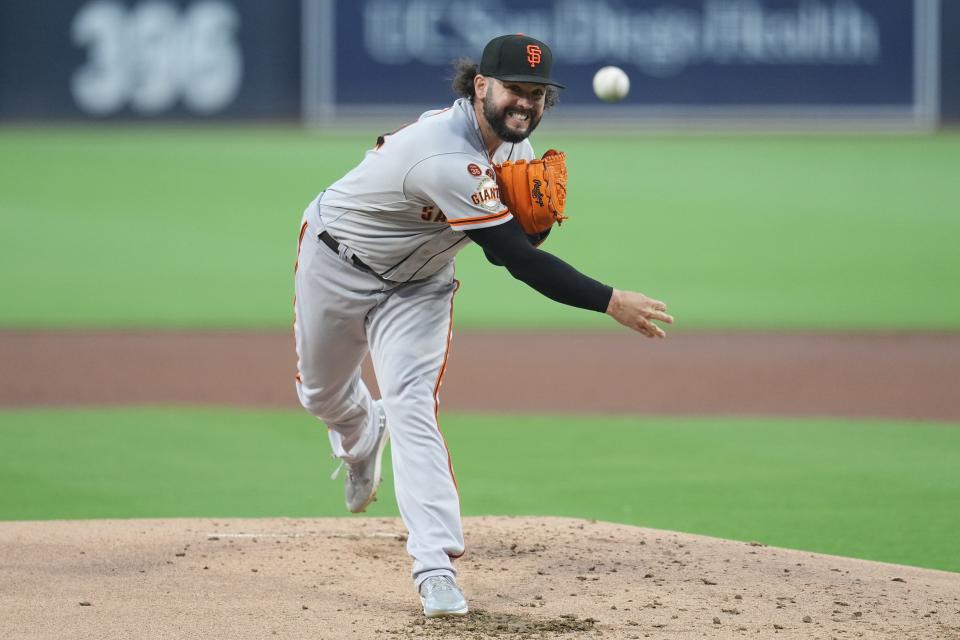4 observations about the new-look Brewers starting rotation for 2024
As the Milwaukee Brewers report to American Family of Fields of Phoenix, there will be much chatter about who isn’t with the team.
For the first time since 2016, neither Corbin Burnes nor Brandon Woodruff will pitch for the Brewers following an off-season in which two of the best homegrown pitchers in franchise history saw their tenures come to an end, one via trade and the other via a non-tender due to injury.
In their places, the Brewers have assembled a conglomeration of depth to tackle a daunting task.
Freddy Peralta will assume the role of No. 1 starter. Behind him at No. 2 in the rotation is Wade Miley, who Milwaukee re-signed in December. After that? Jakob Junis, Colin Rea and Joe Ross signed with the Brewers this winter and offer veteran depth. Then it’s a cast of youngsters: Aaron Ashby, DL Hall, Robert Gasser, Janson Junk, Carlos Rodriguez, Jacob Misiorowski and Evan McKendry.
As the Brewers head into the season with a handful of question marks surrounding what was an elite unit for a long time, here are four observations on the starting pitching situation in Milwaukee.
Exactly how much pitching production are the Brewers losing?
Burnes and Woodruff established themselves as two of the premier pitchers in the game during their times with the Brewers. Last season, they combined for a 3.11 ERA over 43 starts and 260 ⅔ innings.
Needless to say, results like that don’t just grow on trees.
And the Brewers aren’t only replacing those two, either. Also gone is Adrian Houser, who made 21 starts and pitched in 23 games with a 4.12 ERA.
Between the three righties, the Brewers subtracted 64 starts, 372 innings and a 3.41 ERA.
No matter who’s doing the back-filling, that is still a lot of productivity to replace, especially when the new pitchers brought into the mix are Junis and Ross to go along with a group of young, unproven arms.
There, of course, is no direct replacement for losing this kind of production. The Brewers certainly know this.
What they are trying to do, though, is cobble together some relatively-similar facsimile of the overall run prevention through starting depth and a proven group of relievers.
That, of course, is easier said than done. Losing 64 starts of a 3.41 ERA is a real challenge. There are reasons for optimism with each of the pitchers tasked with stepping into Burnes and Woodruff-sized shoes, but there are plenty of questions around each one, too.
There are at least two things working in the Brewers favor as they seek a new-look rotation.
To start, pitching depth matters. It’s probably the strength of this unit.
Between Rea, Junis, Hall, Ross, Ashby, Gasser and even the likes of Jacob Misiorowski and Carlos Rodriguez, the Brewers only need a couple to perform well behind Peralta and Miley.
The second reason for optimism is that you can, in fact, win in baseball without elite run prevention. Scoring runs helps, too. Milwaukee’s formula has been to build around pitching and defense in recent years, and by being at the top of the league in those areas it allowed the team to overcome offenses ranked in the bottom third of the league.
By all accounts, the Brewers offense should be better this year. By bringing in Rhys Hoskins, Gary Sanchez and Jackson Chourio and shedding poor-performing hitters like Jesse Winker and Rowdy Tellez, the Brewers should score more runs. If the pitching staff is merely good instead of elite but the offense is above average rather than poor, perhaps it all balances out for Milwaukee.
Freddy Peralta showed signs of making a jump last year

The Brewers may be able to replace some of the frontline ace production thanks to Freddy Peralta, who would be one of the top starters in baseball if he pitches like he did in the second half last year.
The righty led all MLB starters in strikeout percentage (36.3%) and K-BB% (30.6%) after the all-star break. He recorded a 2.81 ERA and 0.88 WHIP across his 13 starts, at times struggling to keep the ball in the park but more than balancing that by displaying at the same time both his best strikeout ability and control that he ever has in his career.
Much will be asked of Peralta this year. He has shown throughout his career he’s capable of pitching at a remarkably high level, but the bigger question may be more about how he will handle the workload. Last year, Peralta showed up to camp stronger, leaner and more conditioned than ever before and produced some of the best results of his career. It was no coincidence that he threw more than 150 innings for the first time, too.
The Brewers will need Peralta to repeat his 2023 season, both in performance and health, to go where they want in 2024.
Jakob Junis will slide into a larger role

Why did the Brewers tab Junis to step into the rotation almost immediately after trading Burnes?
The biggest reason: He throws a mean slider.
Among pitchers who threw at least 80 innings last year – so, a sample of almost entirely starters, which Junis will be in 2024 – Junis’ ranked 11th by Stuff+, a pitch modeling metric which takes into account all the various metrics that individual pitch types possess. The slider gets tons of horizontal sweep and generated whiffs on 32.5% of swings last year while holding opponents to a .216 average against. He also threw it a whopping 62.5% of the time.
How Junis and the Brewers choose to mix his pitches will be the storyline to follow with the right-hander. Junis worked almost entirely out of the bullpen last year as a swingman, and it’s almost unheard of for a starter to throw a secondary pitch that often.
The conundrum for Junis in recent years is that he has lacked a truly viable third offering to go along with his slider and sinker. Junis will likely focus on improving his changeup, which will be an important pitch as he faces lineups multiple times as a starter.
When do we see the likes of Aaron Ashby, Robert Gasser and DL Hall?
As of now, it’s hard to see more than one of the Brewers’ young arms cracking the opening day rotation. The Brewers could even go with a veteran group of Peralta, Miley, Junis, Rea and Ross to start the season, which would leave the likes of Hall, Ashby and Gasser – the three youngsters truly vying for a roster spot this spring – on the outside looking in.
The Brewers will need all three of those young arms to get through 162 games, whether as starters or in relief.
Is Ashby fully healthy after missing the entire 2023 season, first by undergoing shoulder surgery and then never fully regaining his velocity while rehabbing? Has Hall shown any progress in improving his command? Is Gasser enough of a polished product with his third and fourth offerings that he can pitch in the majors right away?
These questions will all be worth monitoring throughout camp.
More: These are the best starting pitching efforts in Brewers history
This article originally appeared on Milwaukee Journal Sentinel: Freddy Peralta to lead Milwaukee Brewers rotation for 2024 season

